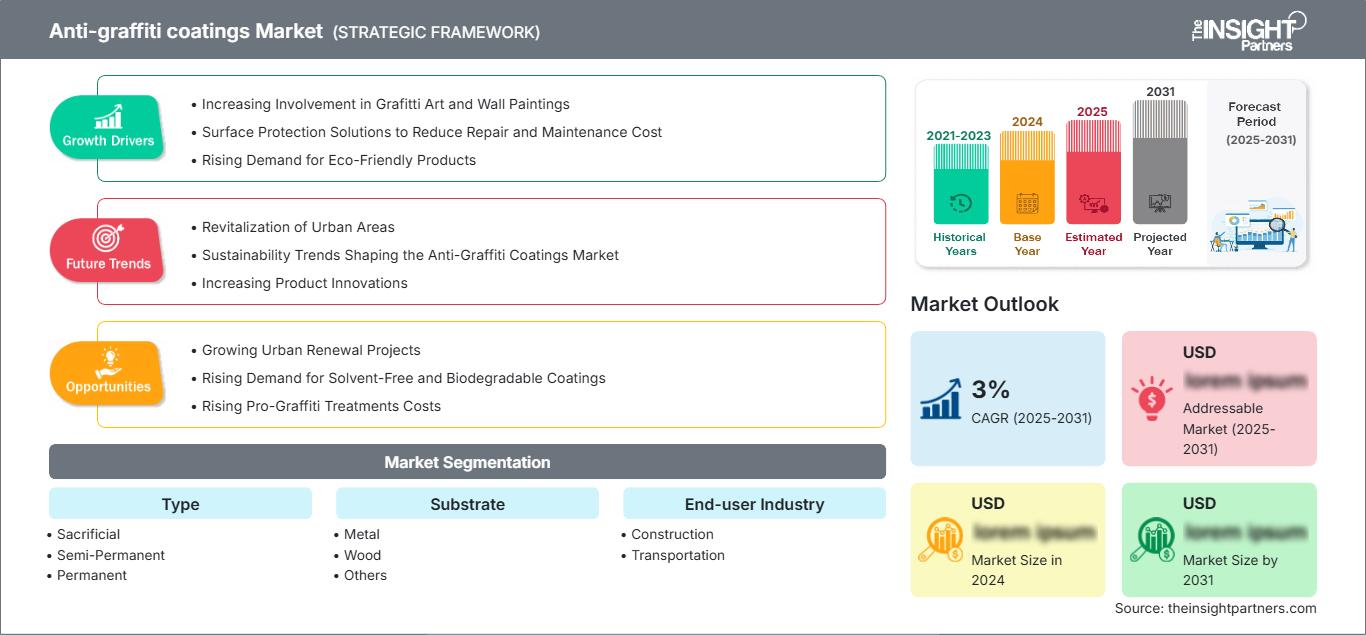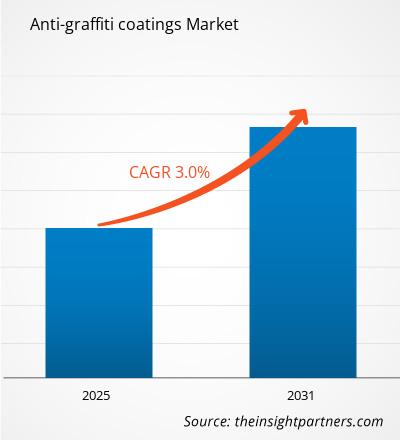Le marché des revêtements anti-graffiti devrait enregistrer un TCAC de 3 % entre 2025 et 2031, avec une taille de marché passant de XX millions de dollars américains en 2024 à XX millions de dollars américains d'ici 2031.
Le rapport est segmenté par type (sacrificiel, semi-permanent, permanent). L'analyse mondiale est ensuite ventilée au niveau régional et par principaux pays. Le rapport présente également une analyse basée sur le substrat (métal, bois, autres). L'analyse mondiale est ensuite ventilée au niveau régional et par principaux pays. La taille du marché et les prévisions aux niveaux mondial, régional et national pour tous les segments de marché clés sont couvertes dans le cadre du rapport. Le rapport fournit la valeur en USD pour l'analyse et les segments ci-dessus. Français Le rapport fournit des statistiques clés sur l'état du marché des principaux acteurs du marché et offre des tendances et des opportunités de marché.
Objectif du rapport
Le rapport sur le marché des revêtements anti-graffiti de The Insight Partners vise à décrire le paysage actuel et la croissance future, les principaux facteurs moteurs, les défis et les opportunités. Cela fournira des informations à diverses parties prenantes commerciales, telles que :
- Fournisseurs de technologies/Fabricants : Pour comprendre l'évolution de la dynamique du marché et connaître les opportunités de croissance potentielles, leur permettant de prendre des décisions stratégiques éclairées.
- Investisseurs : Pour mener une analyse complète des tendances concernant le taux de croissance du marché, les projections financières du marché et les opportunités qui existent tout au long de la chaîne de valeur.
- Organismes de réglementation : Pour réglementer les politiques et les activités de police sur le marché dans le but de minimiser les abus, de préserver la confiance des investisseurs et de maintenir l'intégrité et la stabilité du marché.
Type de segmentation du marché des revêtements anti-graffiti
- Sacrificiel
- Semi-permanent
- Permanent
Substrat
- Métal
- Bois
- Autres
Industrie d'utilisation finale
- Construction
- Transport
Géographie
- Amérique du Nord
- Europe
- Asie-Pacifique
- Amérique du Sud et centrale
- Moyen-Orient et Afrique
Vous bénéficierez d’une personnalisation sur n’importe quel rapport - gratuitement - y compris des parties de ce rapport, ou une analyse au niveau du pays, un pack de données Excel, ainsi que de profiter d’offres exceptionnelles et de réductions pour les start-ups et les universités
Marché des revêtements anti-graffiti: Perspectives stratégiques

- Obtenez les principales tendances clés du marché de ce rapport.Cet échantillon GRATUIT comprendra une analyse de données, allant des tendances du marché aux estimations et prévisions.
Moteurs de croissance du marché des revêtements anti-graffiti
- Implication croissante dans l'art du graffiti et les peintures murales : La transformation des infrastructures urbaines en meilleurs développements a entraîné une augmentation des cas de jeunes s'adonnant à l'art du graffiti sur les murs et les trottoirs. Les surfaces anti-vandalisme dans les bâtiments de construction modernes constituent une excellente solution et sont donc de plus en plus adoptées par les municipalités soucieuses de préserver l'aspect visuel des bâtiments tout en préservant leur valeur.
- Solutions de protection de surface pour réduire les coûts de réparation et d'entretien : Les propriétaires ainsi que les gestionnaires de propriétés se tournent vers la protection de surface afin de réduire les coûts de réparation et d'entretien et d'améliorer la beauté extérieure des bâtiments et des structures. Les revêtements anti-graffiti sont utiles pour atteindre cet objectif, ce qui explique la tendance positive à la croissance de leur application sur les marchés commercial et résidentiel.
- Demande croissante de produits écologiques : Ces dernières années, on a observé une tendance croissante à utiliser des produits plus écologiques. Cela a, à son tour, fait des percées sur le marché des revêtements anti-graffiti. Les fabricants, par exemple, cherchent à rendre ces revêtements biodégradables et à faible teneur en COV afin d'attirer les consommateurs et les entreprises soucieux de la santé de l'environnement, ce qui élargit la base du marché.
Tendances futures du marché des revêtements anti-graffiti
- Revitalisation des zones urbaines : Alors que les zones urbaines se concentrent sur la revitalisation et le développement, la demande de revêtements anti-graffiti devrait augmenter. Les municipalités chercheront des solutions efficaces pour protéger les espaces publics et les biens du vandalisme, stimulant ainsi la croissance du marché.
- Tendances en matière de durabilité qui façonnent le marché des revêtements anti-graffiti : La tendance vers la durabilité façonnera le marché des revêtements anti-graffiti, les fabricants développant des options respectueuses de l'environnement. Les formulations biodégradables et à faible teneur en COV séduiront les consommateurs et les entreprises soucieux de l'environnement, élargissant ainsi la portée du marché.
- Innovations de produits croissantes : Les futures innovations dans les revêtements anti-graffiti se concentreront sur l'amélioration de la durabilité et de la facilité d'application. Les développements qui améliorent la résistance aux intempéries et facilitent le nettoyage stimuleront la demande dans les applications commerciales et résidentielles.
Opportunités de marché des revêtements anti-graffiti
- Croissance des projets de rénovation urbaine : La tendance récente des projets de rénovation urbaine continue de créer un marché stable pour les revêtements anti-graffiti. De plus en plus de municipalités et de particuliers ont tendance à protéger les infrastructures et les surfaces urbaines afin de préserver leur valeur esthétique et économique, ce qui crée un marché permanent.
- Demande croissante de revêtements sans solvant et biodégradables : Les tendances en matière de durabilité se répercutent également sur le marché des revêtements anti-graffiti. Les entreprises qui fabriquent des revêtements biodégradables sans solvants seront certainement en mesure de répondre aux besoins écologiques croissants de la population et des entreprises.
- Augmentation des coûts des traitements anti-graffiti : Anticipant les effets de la hausse des coûts pour les propriétaires, et surtout lorsqu'ils auront pris conscience du coût élevé de l'élimination de ces traitements anti-graffiti, la demande de mesures proactives telles que les revêtements anti-graffiti est bien ancrée. Dans ce contexte, les fabricants devraient tirer profit de la commercialisation de leurs produits comme solutions de protection durable.
Aperçu régional du marché des revêtements anti-graffiti
Les tendances régionales et les facteurs influençant le marché des revêtements anti-graffiti tout au long de la période de prévision ont été analysés en détail par les analystes de The Insight Partners. Cette section aborde également les segments de marché et la géographie des revêtements anti-graffiti en Amérique du Nord, en Europe, en Asie-Pacifique, au Moyen-Orient et en Afrique, ainsi qu'en Amérique du Sud et en Amérique centrale.
Portée du rapport sur le marché des revêtements anti-graffiti
| Attribut de rapport | Détails |
|---|---|
| Taille du marché en 2024 | US$ XX million |
| Taille du marché par 2031 | US$ XX Million |
| TCAC mondial (2025 - 2031) | 3% |
| Données historiques | 2021-2023 |
| Période de prévision | 2025-2031 |
| Segments couverts |
By Type
|
| Régions et pays couverts | Amérique du Nord
|
| Leaders du marché et profils d'entreprises clés |
|
Densité des acteurs du marché des revêtements anti-graffiti : comprendre son impact sur la dynamique des entreprises
Le marché des revêtements anti-graffiti connaît une croissance rapide, porté par une demande croissante des utilisateurs finaux, due à des facteurs tels que l'évolution des préférences des consommateurs, les avancées technologiques et une meilleure connaissance des avantages du produit. Face à cette demande croissante, les entreprises élargissent leur offre, innovent pour répondre aux besoins des consommateurs et capitalisent sur les nouvelles tendances, ce qui alimente la croissance du marché.

- Obtenez le Marché des revêtements anti-graffiti Aperçu des principaux acteurs clés
- Analyse historique (2 ans), année de base, prévision (7 ans) avec TCAC
- Analyse PEST et SWOT
- Taille du marché Valeur / Volume - Mondial, Régional, Pays
- Industrie et paysage concurrentiel
- Ensemble de données Excel
Rapports récents
Rapports connexes
Témoignages
Raison d'acheter
- Prise de décision éclairée
- Compréhension de la dynamique du marché
- Analyse concurrentielle
- Connaissances clients
- Prévisions de marché
- Atténuation des risques
- Planification stratégique
- Justification des investissements
- Identification des marchés émergents
- Amélioration des stratégies marketing
- Amélioration de l'efficacité opérationnelle
- Alignement sur les tendances réglementaires




















 Obtenez un échantillon gratuit pour - Marché des revêtements anti-graffiti
Obtenez un échantillon gratuit pour - Marché des revêtements anti-graffiti